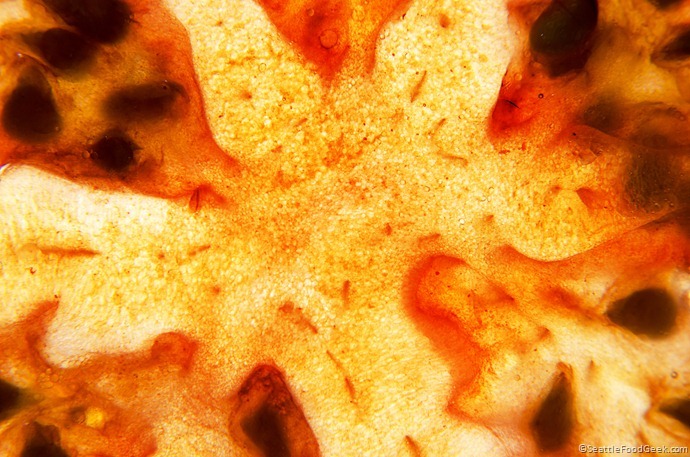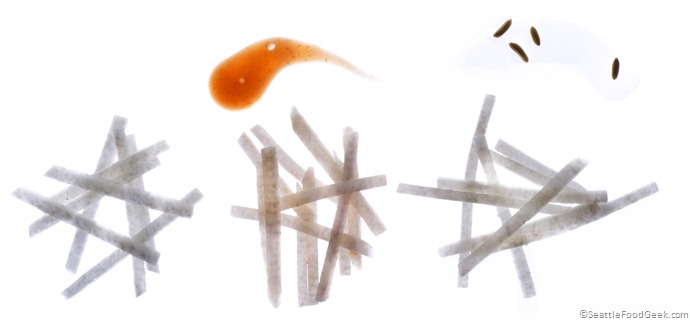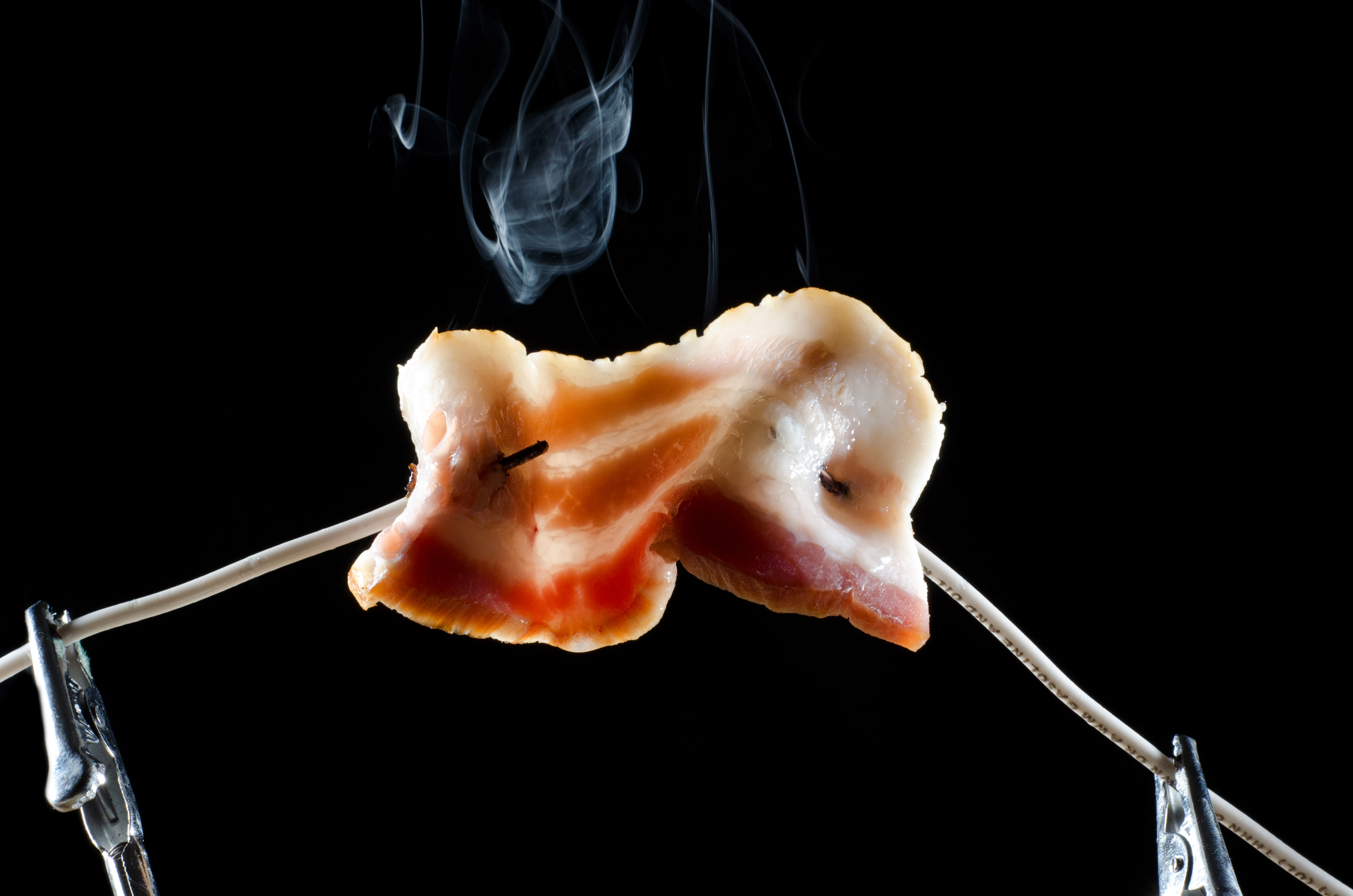
After much ogling, I finally took the plunge and purchased a VacMaster chamber vacuum sealer when I caught an irresistible deal for an older model on Craigslist. I had known for a while that my FoodSaver was woefully inadequate at sealing wet foods for sous vide, but after witnessing how much of a workhorse the chamber sealer is at the Modernist Cuisine lab, I knew it was an essential missing piece of gear for my own kitchen. These are the results of my first real experimentation with the chamber vacuum sealer: “quick pickling.”
A chamber sealer pulls a much stronger vacuum than a FoodSaver – so strong, in fact, that it will boil water at room temperature. When you apply this ultra-strong vacuum pressure to plant foods, you can physically change their cell structure in a way that causes the foods to quickly absorb liquids that surround them. Modernist Cuisine explains the phenomenon best:
The cells of plant tissue contain pockets of air and water called vacuoles. As the outside pressure decreases during vacuum sealing, these vacuoles act like balloons rising up through the atmosphere, and like balloons they eventually pop. The popped vacuoles cannot reinflate[…] so they collapse under the weight of atmospheric pressure as soon as the sealing chamber is opened.[…] Incidentally, this phenomenon also is the reason that infusing liquids into fruits or vegetables under vacuum compression works so well. Once the vacuoles rupture, they quickly fill with any surrounding liquid.
So, I set out to exploit this phenomenon with a bunch of different plant foods. Here are the results.
Tomatoes

The image at the top of this post shows the outcome of my tomato experiments. On the left is a raw tomato, sliced 3mm thick. In the middle is a tomato infused with olive oil. On the right is a tomato infused with olive oil and balsamic vinegar. Since the oil replaces much of the water in the tomato slice, you can safely top these tomatoes with salt without the salt melting, which is a neat trick.
The image just above shows a macro shot of the oil and balsamic tomato slice. You can actually see the expanded vacuoles, which are now filled with oil. As the pressure in the vacuum chamber dropped, the tomatoes boiled vigorously in the olive oil – they actually looked like they were being deep-fried, but at room temperature. I think there’s more to explore here…
Cucumber

Quince

[Raw on the left, infused on the right]. Because the quince was so firm, I sliced it to 3/4mm on the mandoline. I pickled the slices with Noble Tonic No. 4 and thyme. Although they are quite acidic as a standalone snack, they’d make a fantastic garnish for something fatty, like a slab of pork belly or a chunk of tuna. They’re also much more attractive when they turn translucent.
Jicama

Turnip

I’m very excited about the results of this first round of testing, and I look forward to more experimentation with the chamber sealer.

I just bought a vacmaster too! I am excited,
In the video with the tomato in oil, is the boiling the water in the tomato or the oil? If the former, and you leave in under vacuum longer, do you end up boiling away most of the water and replacing it all with oil in the burst vacuoles?
The way you set this up is perfect, such creativity!
– “Hostess” for The MenView
Hey Scott. I noticed that you opted for the VacMaster VP210 and not the VP112. Any reasoning behind that? I’m in the market for a chamber vac and was just wondering if you thought the 210 was better for some reason. Or if you just got it cheaper…
I can’t tell you why he opted for the 210, however after much research I just purchased one today myself, and the biggest determining factor, was that the 210 has a pump that doesn’t use oil and thus doesn’t require maintenance. I had a Freeze Dryer previously and you had to change the oil after every use on my unit (you can get maintenance free there now too) I hated it and I sold the freeze dryer for that reason.
How does this compare with an infusion using an ISI whipper? I’d love to see some comparative shots to see the difference between a negative pressure and a positive pressure technique.
I have a MVS31 chamber sealer from MiniPack –
I use it for many things – as speed pickel things.
A little fun thing is to vaccum a peace of watermelon with extra watermelon juice – it is amazing to watch and to taste.
http://fjordrejen.dk/?p=3370
Kind regards
Erland
Wow! This is neat! I wait for the day when we’ll get a VacMaster here in my part of the world!
Has anyone tried cheaper industrial vacuum chambers like this one? I’m happy with ZipLoc for my sous vide bagging needs, but I’d like to be able to do this sort of thing too.
I have VacMaster’s Chamber Vacuum Sealer. That was easy to made this recipe on it.
I recommend the minipack torre mvs31 chamber vacuum sealer… I use it and it’s really great
The best way to ensure that your children eat healthy is to grow your own vegetables! And the trick to getting your children interested in healthy, organic vegetables is helping them grow their own.
Thanks for the pickling ideas. It seems like you had some great results for your first round of testing.
I comment whenever I especially enjoy a post on a website or I have something to contribute
to the discussion. It is caused by the fire communicated in the article I browsed.
And on this article Quick Pickling Vegetables with a Chamber Vacuum Sealer | Seattle Food Geek. I was excited enough to drop a
comment 😛 I actually do have 2 questions
for you if you usually do not mind. Is it only me or do
a few of these remarks appear as if they are written
by brain dead people? 😛 And, if you are writing on additional sites,
I’d like to follow you. Could you list every one of all your public pages like your linkedin profile, Facebook page or twitter feed?
Wow this is art! Great ideas!
On so many levels, I am more disheartened by the so
called generic commenter” than I am by the blatant spammer.
Why? you might ask, at least the spammer is completely open and
honest with their spam! We know what they are doing.
The generic spammer is a liar and also a faker! You can
probably notice that I have strong feelings toward
this group of idiots
This is a genuinely inspiring posting. I am sincerely impressed by your offerings.
You post useful ideas. Keep it up. Keep blogging. looking forward with true anticipation to seeing your next
blog post.
Pingback: Food fotho | Pearltrees
Pingback: Dani (daniyell) | Pearltrees
My parents got us a Food Saver for Christmas last year and this is perhaps one of the best gifts we’ve received. I have been saving and freezing food items regularly now and it has helped with our food bill, budget, and stopping waste. Since it’s just the two of us sometimes it’s hard to keep food fresh. The Food Saver helps with all this.
Great informations on vacuum sealer. I am currently doing some research and found exactly what I was looking for. Thanks for guide!
I have a vacuum sealer. My vacuum sealer also helped me very good food preservation. It helps me to preserve most of the food for my family from day to day. I think that any family should have a vacuum sealer machine.
I also have VacMaster’s Chamber Vacuum Sealer. That was easy to made this recipe on it. Thank for your post!
Pingback: Pickle in a Flash - KaTom Blog
Wow, that was interesting to know.
Thanks for sharing this experiment.
Thanks for sharing such a delicious recipe using a Vacuum Sealer. I have been using a vacuum sealer for last couple a year. Still, now it works perfect and preserved my foods well. I keep my food fresh using my food saver device. I will try to make this recipe on my device, I think it is easy to make this.
Great guide, thank you very much!
Thank you so much for this, you explained it really well and with much explanation. Pickling is something I want to try this weekend and surely this has helped me a lot.
Great info really loved it.
Pingback: Comparatif : Le meilleur appareil de mise sous vide en 2019
I have wanted one of these for a long time – it would be really useful to take advantage of meat and veggies on sale.
☀️ https://goodhometime.com/ ☀️